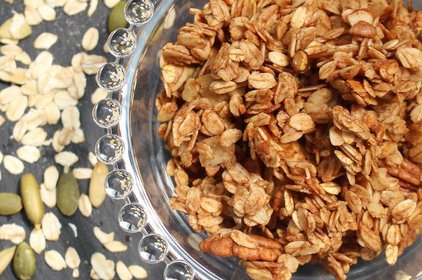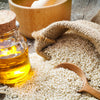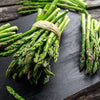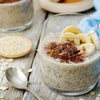The 3 most nutrient-dense whole grains

As you've heard, the Mediterranean diet is one of the world’s healthiest diets and tends to embrace the consumption of some whole grains. But, we’re not talking pasta and white rice ... we're talking about whole grains with the hull intact.
For example, corn is a whole grain vegetable and so are rolled and steel cut oats. Just be absolutely sure to always purchase organic (non-GMO) varieties to avoid unwanted toxins like, glyphosate.
In a recent meta-analysis, researchers found that people who ate 70 grams a day of whole grains had a 20% lower risk of dying from cancer, a 23% lower chance of dying from cardiovascular disease, and a 22% lower chance of mortality, period. Eating whole grains regularly has been found to reduce the chance of developing diabetes, to improve gut health, and reduce our chance of developing inflammation and inflammation-based diseases.
Naturally, everyone has their own particular health issues. And, if you find that you are negatively affected by eating any grains, you should avoid them. If you know that you have food sensitivities ... it's best to work with an experienced, integrative healthcare provider to help develop the best diet for you.
A closer look at steel cut and rolled oats
Steel cut oats and rolled oats have a similar nutrient-dense profile. The two areas where steel cut beat out rolled oats are in its higher fiber content and it’s lower-glycemic index. "Lower glycemic index" simply means that steel cut oats - due to the higher fiber content - will have a smaller impact on blood sugar levels versus rolled oats.
Either way, both whole grain forms of these oats provide a rich array of minerals, phytonutrients, and antioxidants to protect your health.
Whole grain oatmeal has proven to help improve blood sugar profiles and prevent diabetes, can lower cholesterol, and are rich sources of antioxidants called avenanthramides that help lower blood pressure by enhancing the production of nitric oxide in the blood. Just be sure to use "plain" varieties, not ones sweetened with brown sugar or maple syrup for obvious reasons.
Oats also help to dilate blood vessels and prevent blood clots, improve blood flow, and help fight inflammation as well. Also, whole grain oats improve our ability to move stool through the body and lower the risk of constipation.
How to cook the perfect bowl of steel cut oats:
Steps one
Heat 3 cups of water. While that is heating up over a medium heat to just a simmer, sauté 1 cup of steel cut oats in a little grass-fed butter or dry roast. This helps to soften that hull (much like you do if you follow certain brown rice cooking recipes), for around two minutes. This will enhance the flavor, as well.
Don’t forget, just toast the oats then remove from the heat - just as you detect a pleasant grainy scent in the air.
Step 2
Add the oats to the simmering water with a pinch of sea salt.
Step 3
Simmer gently for around 20 minutes, stirring so that they don’t stick or scorch. Continue cooking until all water is absorbed and oats are very soft.
Step 4
Stir in any additions you like from dried fruit or some nourishing seeds. The possibilities are nearly endless.
Preparing Rolled Oats
Combine 1/2 cup rolled oats with one cup of water. Heat until simmering and simmer 3 to 5 minutes. You never want to boil it.
The wonders of amaranth
Amaranth is one of the healthiest whole grains, offering a rich store of hard to get minerals and trace minerals like manganese (105% of the RDI). Plus, amaranth offers plenty of magnesium (40% of the RDI), iron (29% of the RDI), and phosphorus (36% of the RDI).
This uncommon grain is also rich in special antioxidants called gallic acid, p-hydroxybenzoic acid and vanillic acid, which have proven in studies to protect us against heart disease and cancer.
To cook amaranth: Put amaranth in water with amaranth in a 3:1 (or three cups water to one cup amaranth). Heat until it reaches a boil and then reduce the heat and let it simmer 20 minutes or until the water is absorbed.
Use it in place of rice or noodles in soups or stews or serve it like you might porridge or Cream of Wheat cereal, with nuts, cranberries or blueberries.
Choose your corn wisely
Corn is both a whole grain and a vegetable and it needs to be rescued from its "bad-boy" reputation, gained much from high fructose corn syrup or its genetically manipulated varieties that pollute the market place.
Conversely, organic (non-GMO) corn is actually good for eyesight and is one of the few vegetables that contain a wide array of phytochemicals that are most essential nutrients for the eyes, such as lutein, zeaxanthin, and carotenoids that are essential for eye health.
And, as researchers note, “Corn nutrients and phytochemicals include vitamins (A, B, E, and K), minerals (Mg, P, and K), phenolic acids (ferulic acid, coumaric acid, and syringic acid), carotenoids and flavonoids (anthocyanins), and dietary fiber.”
Some of these compounds are cancer-fighting (syringic acid) and neurogenesis-promoting - meaning that corn helps protect brain health and spark new brain cell growth.
Best ways to cook corn: Corn tastes great roasted, fried, boiled, or stir fried with some of your other favorite vegetables like, onions and carrots. For added richness, you can add a small amount of grass fed butter or extra virgin olive oil.
Keep in mind, you must eat healthy fats to help absorb certain fat-soluble nutrients. Whatever you decide, be sure to eat a wide variety of healthy (organic) foods to protect your health.
Sources for this article include:






